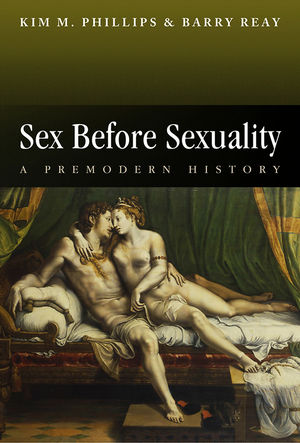 Sex before Sexuality argues contemporary terminology like ‘gay’ or even ‘heterosexual’ were completely alien to Medieval and premodern societies. Chris Parkes thinks the book helpfully carves a path for future scholars whilst demonstrating the urgent need for a fresh look at premodern sexualities.
Sex before Sexuality argues contemporary terminology like ‘gay’ or even ‘heterosexual’ were completely alien to Medieval and premodern societies. Chris Parkes thinks the book helpfully carves a path for future scholars whilst demonstrating the urgent need for a fresh look at premodern sexualities.
 Sex Before Sexuality: A Premodern History. Kim M Phillips and Barry Reay. Polity Press. August 2011.
Sex Before Sexuality: A Premodern History. Kim M Phillips and Barry Reay. Polity Press. August 2011.
With the recent passage of a constitutional amendment in North Carolina forbidding any recognition of marriage or domestic partnerships for gays and lesbians it can sometimes seem as if medieval attitudes toward sexuality are with us still today. But as Kim M. Phillips and Barry Reay argue in their new book, Sex Before Sexuality: A Premodern History, the definitions of sexual identity and expression assumed in contemporary terms like ‘gays’ and ‘lesbians’ would be as unrecognizable to inhabitants of the Medieval and premodern worlds as would the terms ‘domestic partnership’ or ‘North Carolina’.
Phillips and Reay, specialists in medieval sexuality and premodern/modern sexuality respectively, propose a reassessment of traditional interpretations of premodern sexual history. “By spanning the traditional period divide,” they argue, “we hope to draw attention to features that remain constant as well as those that obviously change.”
Furthermore, through this analysis the authors argue for the inapplicability of modern sexual nomenclature to premodern and medieval contexts. This assertion is not especially novel, which the authors recognise in their introduction. This should not necessarily be viewed negatively. Historians of sexuality have bickered over the essentialist/constructivist debate for decades and no single book is likely to bring an end to that debate any time soon. Notwithstanding their modest intellectual ambit, Phillips and Reay offer an impressive catalogue of the Medieval and premodern sexuality with glimmers of insight about shifting expressions of gender and sexuality over a broad swath of Western history.
Sex Before Sexuality divides into five thematic chapters: sin, heterosexual courtship, male homosexuality, female homosexuality, and pornography. According to the authors, these terms are inappropriate to describe the actual content of these chapters. Although in the interests of clarity this reviewer has opted to use the more recognisable, albeit less precise, modern terms.
Each chapter examines the evolution of its respective aspect of sexual expression from the high Middle Ages to the early modern era (approx. 1100-1700) employing an impressive array of evidence. The first chapter contains the most thorough research and theoretical backing. It cleverly traces the contours of different conceptions about sexuality and sin within the Catholic Church between Germanic and Mediterranean cultures from their post-Roman origins through to the religious schisms of the Reformation era. True to their intent, the authors effectively demonstrate the presence of continuity and change in Christian views about sex. They also point to the high degree of diversity in those opinions that other scholars have so far overlooked.
Subsequent chapters are less original but no less compelling in their demonstration of how modern terms prove anachronistic when applied to premodern sexual cultures. Phillips and Reay compile a bewildering catalogue of sexual activities and identities exploring each in turn, from general conceptions of affection (courtly love, pastourelles) to specific sexual sub groups (mollies, Sapphic love, etc.). The indisputable conclusion reached in each case is that Medieval and premodern sexualities refuse to conform to contemporary conceptions of sexual practice or identity. Scholars studying these periods who employ such contemporary terms undermine their analytical precision by refusing to acknowledge the anachronistic context of their chosen terminology. The point is a valid one and the authors contribute substantially to existing and future scholarship by arguing it.
However, in its zeal to expose the unsuitability of modern terms to premodern sexualities Sex and Sexuality opens itself up to a critical shortcoming. Arguing for the inapplicability of modern terms to earlier sexual cultures while analyzing both Medieval and premodern sexualities in the same book begs the question: are not the attitudes toward sexuality from one period, say 1550, sufficiently different from the attitudes of several hundred years earlier to render any comparison moot? This apparent contradiction is illuminated in the epilogue. In what amounts to a case study of the encounters between Captain Cook and the indigenous inhabitants of the South Pacific, Phillips and Reay try to condense the arguments of the previous five chapters into a single example of how Europeans interpreted a new sexual paradigm through their own understanding built on 700 years of ideation.
The anecdotal accounts are compelling, but their relevance to the rest of the book is tenuous. How sailors in the late eighteenth century reacted to Polynesian sexuality gives little insight into twelfth century monastic asceticism. Moreover, the choice of case study seems to have less to do with its applicability to medieval and premodern sexual cultures and more to do with the authors’ antipodean origins.
Overall, Sex Before Sexuality is an excellent summary of premodern sexual history that will be valuable to scholars seeking a reference guide on the subject. Beyond this, the book is too timid to attempt an independent re-categorisation of the sexual cultures it explores, but it helpfully carves a path for future scholars to follow whilst demonstrating the urgent need for a fresh look at premodern sexualities freed from the myopic restrictions of present day terminology.
——————————————————————————————-
Chris Parkes is a third year PhD student at LSE, specialising in American political and social history during the twentieth century. His interests include the history of sexuality, foreign policy, and modern American cultural history. His thesis explores the life and career of former Undersecretary of State Sumner Welles as well as the role of sexuality in the federal government during the 1930s and 1940s. He has published in the American National Biography and presented work at conferences across the UK and Europe. Read more reviews by Chris.







